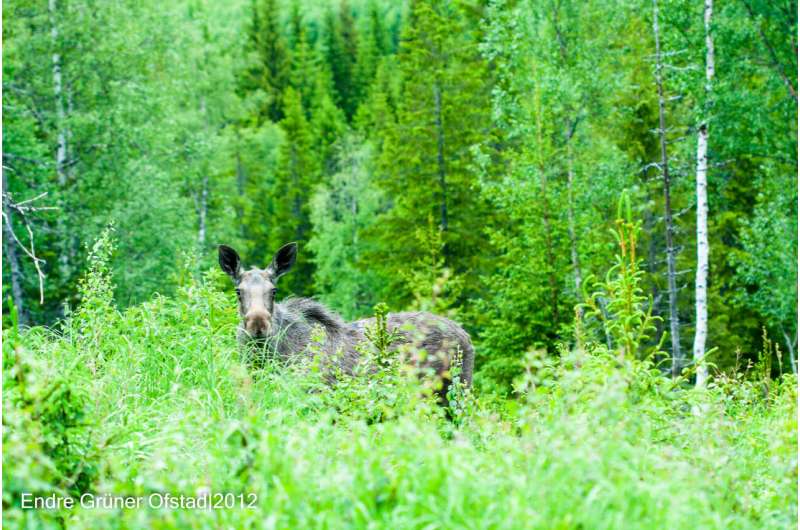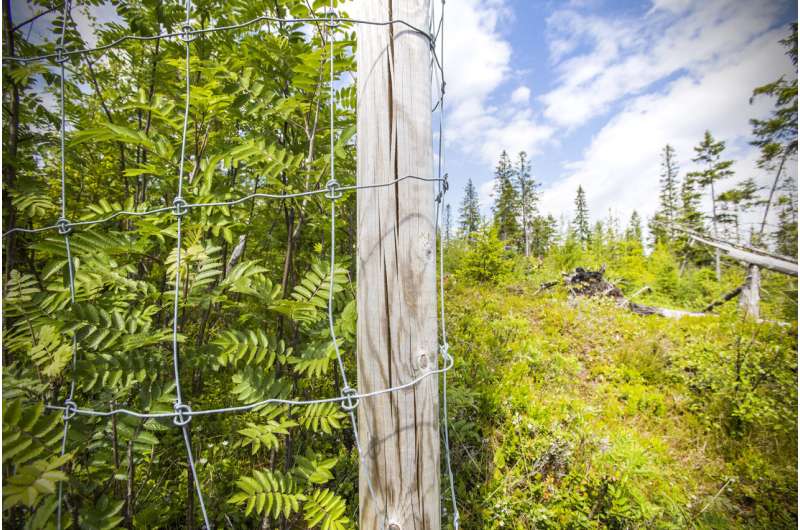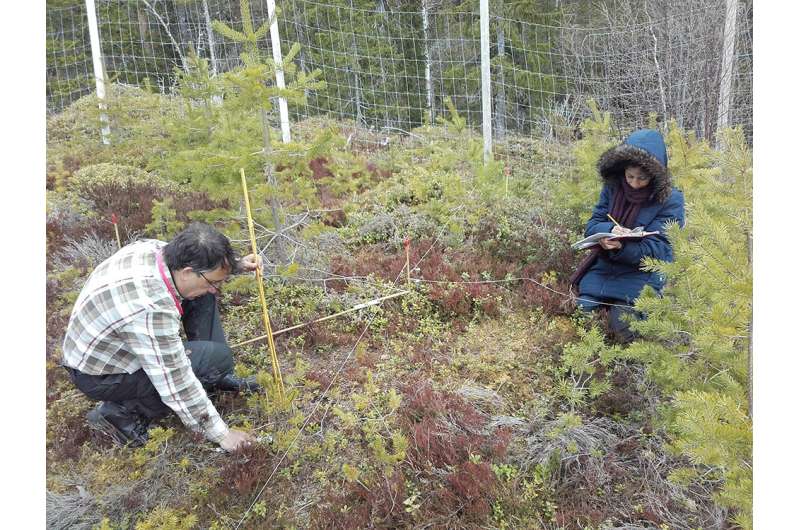This article has been reviewed according to Science X's editorial process and policies. Editors have highlighted the following attributes while ensuring the content's credibility:
fact-checked
trusted source
proofread
Moose could play a big role in global warming

One of the biggest potential single sources of carbon emissions from wooded parts of Norway has four legs, weighs as much as 400-550 kg and has antlers.
That's right—moose can reduce carbon storage in clearcut sites equivalent to as much as 60 percent of the annual fossil fuel carbon emissions from a region, a new study shows.
"Moose are an ecosystem engineer in the forest ecosystem, and strongly impact everything from the species composition and nutrient availability in the forest," said Gunnar Austrheim, an ecologist at the NTNU University Museum who was one of the study's co-authors. "A grown animal can eat 50 kilograms of biomass each day during summer."
That consumption represents roughly 10 percent of what the Norwegian forest industry itself harvests, he said.
And therein lies the reason why moose can be responsible for such a large additional amount of carbon emissions, said Francesco Cherubini, director of NTNU's Industrial Ecology (IndEcol) Program, and co-author of the paper.
Moose influence vegetation growth and more
Moose like to eat young deciduous trees, like birch, rowan and willow. So the young saplings that would normally sprout in the forest after a timber company clearcuts an area never get the chance to grow.
When saplings grow into mature trees, they bind up CO2 in their trunks, leaves and roots. Moose essentially gobble up that possible source of carbon storage.
"It was really a surprise to see how much moose can influence vegetation growth, the carbon cycle and the climate system," said Xiangping Hu, a researcher at IndEcol and co-author of the study.
Scientists have known that browsing by large animals like moose could be an unaccounted-for source of additional carbon emissions, but there are very few studies with actual numbers to say precisely how much, Hu said.
Filling in the unknowns in climate modeling
Researchers use computer models to try to predict future climate scenarios, based on current and expected emissions of carbon dioxide and other greenhouse gasses.
That's basically the information we get from the Intergovernmental Panel on Climate Change, or IPCC.

Most recently, the IPCC said humanity is on track to raise the Earth's average temperate by 2.4 C, which is quite a bit higher than the 1.5 C goal that scientists agree we should aim for.
The challenge is that climate modeling is imperfect. It's getting better, but there are areas where researchers simply don't have enough information yet.
They know there are factors that should be in their climate models, but they simply don't have enough data to include those factors in a realistic way.
The effects of large animals are one of those factors, Cherubini said.
"One of the biggest unknowns that we have in our understanding of the climate system and the carbon cycle is potentially the effect of larger animals, and how they interact with carbon storage in vegetation," he said.
"This study gave us a great opportunity to quantify this effect," he said. "We have some numbers that we can relate to the regional carbon budget, and which actually show the importance of large animals like the moose."
Good for the forest industry, maybe not so good for the climate
The researchers were able to discover the importance of moose on climate as a result of a different, but related study that began in 2008.
At that time, researchers at NTNU and NINA ( the Norwegian Institute for Nature Research) wanted to know what effect moose had on the forest ecosystem after an area had been clearcut. They looked at vegetation regrowth, species diversity and soil nutrient dynamics. Clearcutting is a process where essentially all trees are harvested from an area.
So the researchers set up 47 paired plots in areas that had been clear-cut in the previous three years. One of the plot pairs was fenced off so that moose couldn't browse on the tasty new saplings that naturally spring up after an area has been cut.
The second, nearby plot pair, was open to moose but marked so that researchers could go back year after year to see what happened to tree regrowth and other ecosystem metrics as moose feasted on the vegetation.
What they found was that moose were doing Norway's forest industry a huge favor, Cherubini said.
"So the forest industry prefers coniferous species, they prefer pine, they prefer spruce. So moose to some extent, are helping them because they're reducing competition," by thinning out the deciduous trees and partly pine, leaving the spruce, he said.

Win for the climate, biodiversity and forest management?
The researchers realized they could revisit the plots to study effects on carbon emissions by calculating the differences in aboveground carbon content between browsed and unbrowsed plots.
That enabled them to see potential additional carbon emissions that moose caused by eating deciduous saplings.
Birch and other highly selected deciduous species such as rowan, willow and aspen may also help contribute to the biodiversity of an area, Austrheim said, which moose also affect by removing those species.
So while moose were relatively good for the forest industry, they aren't necessarily that good for the climate or biodiversity.
But there's good news.
Finding a balance
Almost all of Norway's productive forests are harvested using clearcuts.
"These clearcuts provide a lot of good food for moose," Austrheim said. Moose are also very heavily managed in Norway, he said.
"We don't only regulate the amount of animals, we very carefully regulate the proportion of females, males and calves. So there's a stronger management for moose than for most livestock in Norway," he said.
That means it should be possible to find the right balance between moose numbers and how forested lands are managed. That, in turn, could make it possible to limit excess carbon emissions, boost biodiversity and increase forest productivity, the researchers said.
"I think as we get more of an understanding of how all these different things are interrelated, land managers could come up with an optimal plan," Cherubini said. "That could be a much needed win-win solution for climate, for biodiversity and for timber value."
The research is published in the Journal of Geophysical Research: Biogeosciences.
More information: John Salisbury et al, Net climate effects of moose browsing in early successional boreal forests by integrating carbon and albedo dynamics, Journal of Geophysical Research: Biogeosciences (2023). DOI: 10.1029/2022JG007279
Provided by Norwegian University of Science and Technology
















